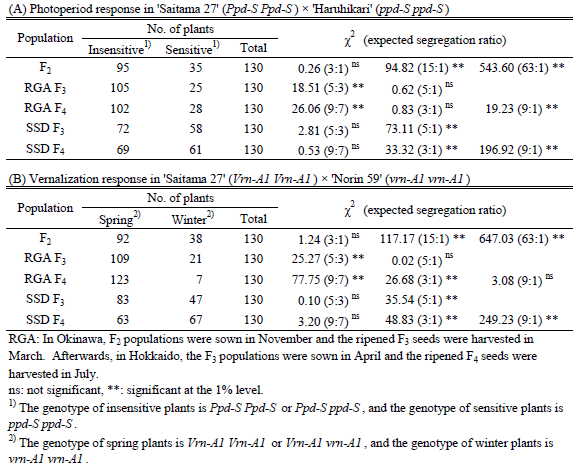Effect of shuttle breeding by taking advantage of the wide latitude in Japan for heading traits of wheat
Description
Usually it takes many years to breed wheat cultivars. Rapid generation advancement is, therefore, one of the more important techniques for shortening the process. On the other hand, photoperiod response (photoperiod-sensitive or insensitive) and vernalization response (winter or spring growth habit), which are controlled by Ppd and Vrn genes, respectively, are particularly important physiological characters, since they are responsible for earliness of heading and are thus closely related to regional adaptability. If the desirable Ppd and Vrn genotypes can be selected by natural and artificial selection during rapid generation advancement, its system should be very efficient. In this study, to establish an efficient method of rapid generation advancement applicable to spring wheat breeding programmes, the impact of shuttle breeding through fall-sown cultivation on Ishigaki (24˚N), Okinawa, in the southernmost part of Japan, followed by the spring-sown cultivation at Memuro (42˚N), Hokkaido in the northernmost part of Japan on the fluctuation in the frequency of the Ppd and Vrn genotypes was investigated.
Analysis of heading date in characteristic wheat cultivars and the F2 populations indicated that the earliness of heading in Okinawa and Hokkaido was closely related to both Ppd and Vrn genotypes and the Vrn genotype, respectively. The two hybrid populations segregating for Ppd or Vrn genes, ‘Saitama 27’ (Ppd-S, Vrn-A1) × ‘Haruhikari’ (no Ppd genes, Vrn-A1 Vrn-B1) and ‘Saitama 27’ × ‘Norin 59’ (Ppd-S, no Vrn genes), were treated using rapid generation advancement (F2: Okinawa, F3: Hokkaido). As a control, the same cross combinations were also treated using the single seed descent method in F2 - F3 generations. The analysis of their photoperiod and vernalization responses showed that plants with photoperiod-sensitivity and winter growth habit were eliminated in Okinawa and those with winter growth habit were eliminated in Hokkaido (Table).
The present study proved this system of rapid generation advancement to be effective in eliminating the photoperiod-sensitive and winter types, therefore making it useful for photoperiod-insensitive spring wheat breeding. In addition, it was considered that, in a cross combination between distantly related parents, the following shuttle breeding system scheme would be appropriate, taking the degree of fixation into account: 1st year (F2: Okinawa, F3: Hokkaido) and 2nd year (F4: Okinawa, F5: Hokkaido). On the other hand, for photoperiod-sensitive spring wheat breeding, a long-day treatment is necessary to avoid eliminating photoperiod-sensitive types in fall-sown cultivation in Okinawa.
Figure, table
-
Table1. Fluctuation in photoperiod response (A) and vernalization response (B) with rapid generation advancement (RGA) or single seed descent (SSD) in two wheat hybrid populations
- Affiliation
-
Japan International Research Center for Agricultural Sciences Okinawa Subtropical Station
- Classification
-
Technical A
- Term of research
-
FY2005(FY2002~2005)
- Responsible researcher
-
TANIO Masahiko ( Okinawa Subtropical Station )
TAMURA Yasuaki ( Okinawa Subtropical Station )
SATO Mitsunori ( Okinawa Subtropical Station )
TAKAGI Hiroko ( Okinawa Subtropical Station )
MATSUOKA Makoto ( Agriculture, Forestry and Fisheries Research Council Secretariat, Ministry of Agriculture, Forestry and Fisheries )
TABIKI Tadashi ( Hokkaido Agricultural Research Center, NARO )
NISHIO Zenta ( Hokkaido Agricultural Research Center, NARO )
OTOBE Chikako ( Institute of Crop Science, NARO )
ISHIKAWA Naoyuki ( National Agricultural Research Center for Western Region )
TAIRA Masato ( Kyushu Agricultural Experiment Station )
HATANO Tetsuya ( Kyushu Agricultural Experiment Station )
ARAKI Kazuya ( Hokkaido Kitami Agricultural Experiment Station )
NAKAMICHI Koji ( Hokkaido Kitami Agricultural Experiment Station )
KATO Kenji ( Okayama University )
- ほか
- Publication, etc.
-
Tanio,M. et al. (2003) Breeding research 5 (Supl. 1), 116.
Tanio,M. et al. (2004) Breeding research 6 (Supl. 1), 135.
Tanio,M., Kato,K., Ishikawa,N., Tamura,Y., Sato,M., Takagi,H. and Matsuoka,M. (2005): Genetic analysis of photoperiod response in wheat and its relation with the earliness of heading in the southwestern part of Japan. Breeding Science 55: 327-334.
- Japanese PDF
-
2005_seikajouhou_A4_ja_Part18.pdf455.26 KB

